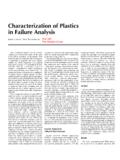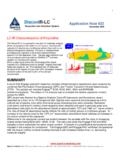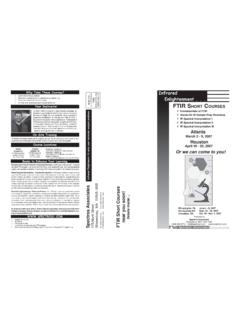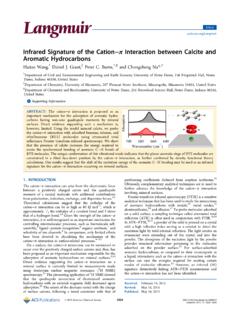Transcription of Chemical Analysis of Polymeric Materials Using …
1 University of Zagreb, Croatia, November 3, 2011 Charles YangDepartment of TextilesThe University of GeorgiaAthens, Athens, GA 30602, USAC hemical Analysis of Polymeric MaterialsUsing infrared SpectroscopyOutlines Basic Theory of infrared SpecrtrocopyMolecular vibrational energy, infrared spectroscopy and its selection rulesInterpretation of infrared spectra, group frequency and finger print region Dispersive versus Fourier transform infrared spectroscopyThe sampling techniques for solids Applications of FT-IR spectroscopy to polymers: qualitative Analysis Applications of FT-IR spectroscopy to polymer: quantitative analysisM1M2 Vibrational Energy of A Diatomic MoleculeV -vibrational quantum number, 0, 1, - Plank constantVm-vibrational frequency - reduced massk-force constantM1M2M2M1 Wavenumber (cm-1) of An IR Absortion Peaka.
2 Force constant-105dynes/cmb. Reduced mass- x 10-24gAn Absorption Peak in An Vibrational SpectrumCO (gas)An Absorption Peak with Rotational Fine Structure in An Vibrational SpectrumCO (gas)Electric Magnetic RadiationNear-, Mid-, and Far- infrared RegionSelection Rules of infrared spectroscopy Excitations from V=0 (ground state) to V=1 (1stexcited state (fundamentals) by absorption of IR radiation Absorption can occur only when there is a change in the magnitude and direction of dipole momentof the bondVibrational Spectra Interpretation.)
3 Group Frequency Start in the group frequency region: 4000-1250 cm-1(-OH, -NH, =C-H, -CH2, -CH3, >CH-, >P-H, >C= ) Easy to interpret, little interference Peak assignmentPeak position (wavenumbers)Peak heightPeak shape infrared Spectra Interpretation: Finger Print Region More complex and more difficult to interpret Small structural differences results in significant in spectral differences Complete interpretation impossible Complete identification requires 100% match between sample s and standard s spectra in the finger print regionInfrared spectroscopy .
4 Group Frequency bending &ring puckeringstr-med690-900C-H (may be several bands)C=C (in ring) (2 bands)(3 if conjugated)varmed-wk30301600 & 1500 ArenesC-H deformationstr600-700C-H (usually sharp)C C (symmetry reduces intensity)strvar33002100-2250 Alkynes=C-H & =CH2(out-of-plane bending)cis-RCH=CHRstrmedmed880-995780-8 50675-730=C-H & =CH2(usually sharp) C=C (symmetry reduces intensity)C=C asymmetric stretchmedvarstr3020-31001630-16801900-2 000 AlkenesCH2& CH3deformationCH3deformationCH2rockingme dmedwk1350-14701370-1390720-725CH3, CH2& CH2 or 3 bandsstr2850-3000 AlkanesAssignmentIntensityRange (cm-1)AssignmentIntensityRange (cm-1)Functional ClassBending VibrationsStretching VibrationsC-O-H bendingN-H (1 -amide) II bandN-H (2 -amide) II bandmedmedmed1395-14401590-1650 1500-1560 O-H (very broad)C=O (H-bonded) O-C (sometimes 2-peaks)C=OC=O (2-bands)O-CC=OO-C (2-bands)C=O (amide I band)
5 Strstrmed-strstrstrstrstrstrstr2500-3300 (acids) overlap C-H1705-1720 (acids)1210-1320 (acids)1785-1815 ( acylhalides) 1750 & 1820 (anhydrides) 1040-1100 1735-1750 (esters) 1000-1300 1630-1695(amides)Carboxylic Acids& Derivatives -CH3bending -CH2bendingC-C-C bendingstrstrmed1350-13601400-1450 1100C-H (aldehyde C-H)C=O (saturated aldehyde) C=O (saturated ketone)aryl ketone , -unsaturationcyclopentanonecyclobutanone medstrstrstrstrstrstr2690-2840(2 bands)1720-17401710-17201690 1675 1745 1780 Aldehydes & KetonesNH2scissoring (1 -amines)NH2& N-H wagging(shifts on H-bonding)med-strvar1550-1650660-900N-H (1 -amines), 2 bandsN-H (2 -amines)C-Nwkwkmed3400-3500 (dil.)
6 Soln.)3300-3400 (dil. soln.)1000-1250 AminesO-H bending (in-plane)O-H bend (out-of-plane)medvar-wk1330-1430650-770O -H (free), usually sharpO-H (H-bonded), usually broadC-Ovarstrstr3580-36503200-3550970-1 250 Alcohols & of infrared SpectraT% = It/I0A = -Log10T%Instrumentation of infrared Spectrometer Source Monochromator (dispersive IR spectrometer) or Interferometer (FT-IR spectrometer) Sample device Detector Data processing, presentation and storage device Dispersive infrared Spectrometer FT-IR SpectrometerFT-IR SpectrometerAdvantages of FT-IR Spectrometry Multiplex advantage, shorter data acquisition time, high S/N ratio by multiple scans High throughput advantage High resolution More accurate frequency/wavelength measurementSampling Techniques for Solids.
7 Transmission Spectra Pressed KBr pellet methodUsed for all solid samplesWater interferenceSample/matrix quantity (2-3%, 200 mg KBr)Fully grinding for sample homogeneity for chemically treated fabrics/fibers Cast film For Polymeric sample soluble in a volatile organic solventChoosing the right window Materials KBr ZnSeInfrared spectroscopy Window MaterialsSampling Techniques for Solids: Reflectance Methods Diffuse reflectance (DRIFTS)Good for samples which can be ground to fine particlesCan be used as a quantitative methodHigh energy throughput and fast data collectionHomogeneous particle size, accessory alignment and sample mounting are important experimental parameters Sampling Techniques for Solids.
8 Reflectance Methods Diffuse reflectance (DRIFTS) Quantitative AnalysisF(R ) maximum peak valuec concentrationK related to particle size and molar absorptivity Use of KBr to collect a reference spectraF(R ) = c/k Sampling Techniques for Solids: Reflectance Methods Internal total reflection A thin and flexible film ( , elastomer) is placed with pressure against the crystal, good optical contact is necessary. It can be used as a near-surface method (left)Single bounce, small area diamond crystal is developed for a variety of solid samples (right)Sampling Techniques for Solids.
9 Photoacoustic Method FT-IR Photoacoustic spectroscopy s Thermal diffusion length (cm) Thermal diffusivity (cm2 s-1) Angular modulation frequency (redians s-1)k Thermal conductivity (cal cm-1 s-1 C-1) Density (g cm-3)C Specific heat (cal g-1 C-1)f modulation frequency (Hz)FT-IR Photoacoustic spectroscopy No sample preparation Near surface Analysis Depth profiling Low sensitivity Interferences (water, )C. Q. Yang, Ind. Eng. Chem. Res., 31, 617-621 (1992)C. Q. Yang, Appl. Spectrosc., 45, 102-108 (1991)Qualitative Analysis of Polymers and Textiles by FT-IR spectroscopy .
10 Part 1 Identification of unknown contaminants of rayon fiber UV-induced oxidation of polyethylene nonwoven fabricIdentification the functional groupsDistribution of the functional groups Thermal oxidation of polyethylene nonwoven fabric Identification the functional groupsDistribution of the functional groupsThe Dyed 2-ply Rayon Yarn with Unknown Contaminations Previously scoured Dyed with a fiber reactive dye Contaminant unknownSpin finishAnother contaminant unknown The yarn was extractedMethylene chloride (polar solvent)Hexane (nonpolar solvDRIFTS Spectra of the Dyed 2-ply Rayon YarnsC.)






